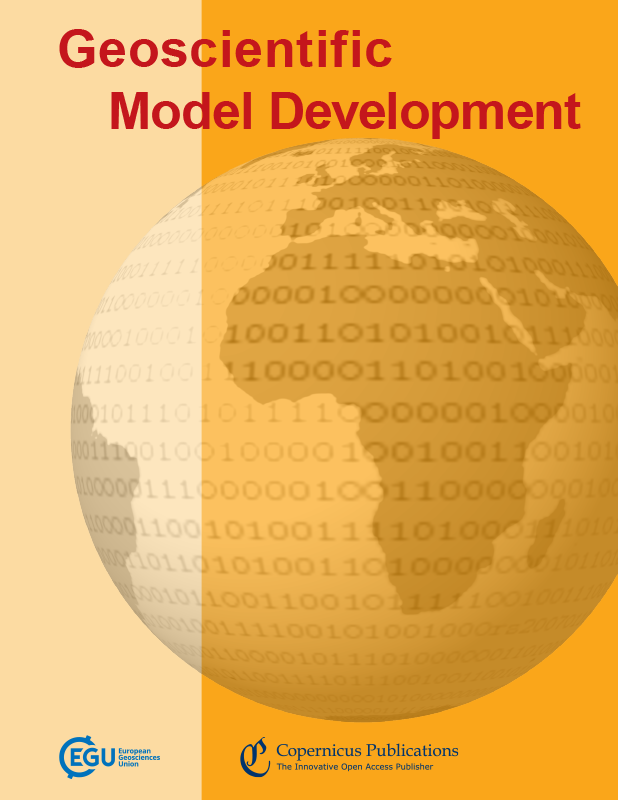冰下水文有约束-无约束含水层系统模型的并行实现:设计、验证和性能分析(CUAS-MPI v0.1.0)
IF 4.9
3区 地球科学
Q1 GEOSCIENCES, MULTIDISCIPLINARY
引用次数: 1
摘要
摘要冰下水文系统通过滑动影响(i)冰盖的运动,(ii)冰缘湖泊的位置,以及(iii)淡水直接在接地线上排放或(iv)通过流经陆地的河流影响海洋环流。为了对该水文系统进行建模,使用了先前开发的多孔介质概念,称为承压-无承压含水层系统(CUAS)。为了在冰盖尺度上进行真实的模拟,我们开发了CUAS-MPI,这是一种MPI并行的C/ c++实现的CUAS (MPI:消息传递接口),它采用了可移植、可扩展的科学计算工具包(PETSc)基础设施来处理网格和方程系统。我们通过将数值结果与涉及两种边界条件的模型方程的一组解析解进行比较,验证了数值结果的准确性。然后,我们研究了CUAS-MPI的缩放行为,并表明在Lichtenberg HPC系统上运行实际格陵兰设置时,CUAS-MPI可以扩展到3840个MPI进程。我们的测量还表明,CUAS-MPI达到了与冰盖模拟相当的吞吐量,例如冰盖和海平面系统模型(ISSM)。最后,我们讨论了冰盖建模的机会,探讨了CUAS-MPI与其他模拟的未来耦合可能性,并考虑了吞吐量瓶颈和进一步扩展的限制。本文章由计算机程序翻译,如有差异,请以英文原文为准。
A parallel implementation of the confined–unconfined aquifer system model for subglacial hydrology: design, verification, and performance analysis (CUAS-MPI v0.1.0)
Abstract. The subglacial hydrological system affects (i) the motion of ice sheets through sliding, (ii) the location of lakes at the ice margin, and (iii) the ocean circulation by freshwater discharge directly at the grounding line or (iv) via rivers flowing over land. For modeling this hydrology system, a previously developed porous-media concept called the confined–unconfined aquifer system (CUAS) is used. To allow for realistic simulations at the ice sheet scale, we developed CUAS-MPI, an MPI-parallel C/C++ implementation of CUAS (MPI: Message Passing Interface), which employs the Portable, Extensible Toolkit for Scientific Computation (PETSc) infrastructure for handling grids and equation systems. We validate the accuracy of the numerical results by comparing them with a set of analytical solutions to the model equations, which involve two types of boundary conditions. We then investigate the scaling behavior of CUAS-MPI and show that CUAS-MPI scales up to 3840 MPI processes running a realistic Greenland setup on the Lichtenberg HPC system. Our measurements also show that CUAS-MPI reaches a throughput comparable to that of ice sheet simulations, e.g., the Ice-sheet and Sea-level System Model (ISSM). Lastly, we discuss opportunities for ice sheet modeling, explore future coupling possibilities of CUAS-MPI with other simulations, and consider throughput bottlenecks and limits of further scaling.
求助全文
通过发布文献求助,成功后即可免费获取论文全文。
去求助
来源期刊

Geoscientific Model Development
GEOSCIENCES, MULTIDISCIPLINARY-
CiteScore
8.60
自引率
9.80%
发文量
352
审稿时长
6-12 weeks
期刊介绍:
Geoscientific Model Development (GMD) is an international scientific journal dedicated to the publication and public discussion of the description, development, and evaluation of numerical models of the Earth system and its components. The following manuscript types can be considered for peer-reviewed publication:
* geoscientific model descriptions, from statistical models to box models to GCMs;
* development and technical papers, describing developments such as new parameterizations or technical aspects of running models such as the reproducibility of results;
* new methods for assessment of models, including work on developing new metrics for assessing model performance and novel ways of comparing model results with observational data;
* papers describing new standard experiments for assessing model performance or novel ways of comparing model results with observational data;
* model experiment descriptions, including experimental details and project protocols;
* full evaluations of previously published models.
 求助内容:
求助内容: 应助结果提醒方式:
应助结果提醒方式:


